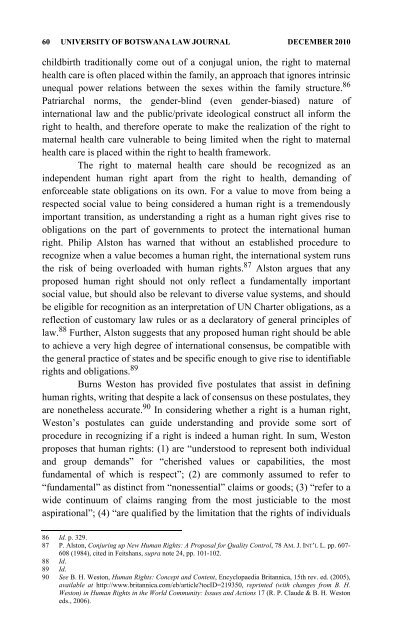University of Botswana Law Journal - PULP
University of Botswana Law Journal - PULP
University of Botswana Law Journal - PULP
You also want an ePaper? Increase the reach of your titles
YUMPU automatically turns print PDFs into web optimized ePapers that Google loves.
60 UNIVERSITY OF BOTSWANA LAW JOURNAL DECEMBER 2010<br />
childbirth traditionally come out <strong>of</strong> a conjugal union, the right to maternal<br />
health care is <strong>of</strong>ten placed within the family, an approach that ignores intrinsic<br />
unequal power relations between the sexes within the family structure. 86<br />
Patriarchal norms, the gender-blind (even gender-biased) nature <strong>of</strong><br />
international law and the public/private ideological construct all inform the<br />
right to health, and therefore operate to make the realization <strong>of</strong> the right to<br />
maternal health care vulnerable to being limited when the right to maternal<br />
health care is placed within the right to health framework.<br />
The right to maternal health care should be recognized as an<br />
independent human right apart from the right to health, demanding <strong>of</strong><br />
enforceable state obligations on its own. For a value to move from being a<br />
respected social value to being considered a human right is a tremendously<br />
important transition, as understanding a right as a human right gives rise to<br />
obligations on the part <strong>of</strong> governments to protect the international human<br />
right. Philip Alston has warned that without an established procedure to<br />
recognize when a value becomes a human right, the international system runs<br />
the risk <strong>of</strong> being overloaded with human rights. 87 Alston argues that any<br />
proposed human right should not only reflect a fundamentally important<br />
social value, but should also be relevant to diverse value systems, and should<br />
be eligible for recognition as an interpretation <strong>of</strong> UN Charter obligations, as a<br />
reflection <strong>of</strong> customary law rules or as a declaratory <strong>of</strong> general principles <strong>of</strong><br />
law. 88 Further, Alston suggests that any proposed human right should be able<br />
to achieve a very high degree <strong>of</strong> international consensus, be compatible with<br />
the general practice <strong>of</strong> states and be specific enough to give rise to identifiable<br />
rights and obligations. 89<br />
Burns Weston has provided five postulates that assist in defining<br />
human rights, writing that despite a lack <strong>of</strong> consensus on these postulates, they<br />
are nonetheless accurate. 90 In considering whether a right is a human right,<br />
Weston’s postulates can guide understanding and provide some sort <strong>of</strong><br />
procedure in recognizing if a right is indeed a human right. In sum, Weston<br />
proposes that human rights: (1) are “understood to represent both individual<br />
and group demands” for “cherished values or capabilities, the most<br />
fundamental <strong>of</strong> which is respect”; (2) are commonly assumed to refer to<br />
“fundamental” as distinct from “nonessential” claims or goods; (3) “refer to a<br />
wide continuum <strong>of</strong> claims ranging from the most justiciable to the most<br />
aspirational”; (4) “are qualified by the limitation that the rights <strong>of</strong> individuals<br />
86 Id. p. 329.<br />
87 P. Alston, Conjuring up New Human Rights: A Proposal for Quality Control, 78 AM. J. INT’L L. pp. 607-<br />
608 (1984), cited in Feitshans, supra note 24, pp. 101-102.<br />
88 Id.<br />
89 Id.<br />
90 See B. H. Weston, Human Rights: Concept and Content, Encyclopaedia Britannica, 15th rev. ed. (2005),<br />
available at http://www.britannica.com/eb/article?tocID=219350, reprinted (with changes from B. H.<br />
Weston) in Human Rights in the World Community: Issues and Actions 17 (R. P. Claude & B. H. Weston<br />
eds., 2006).
















